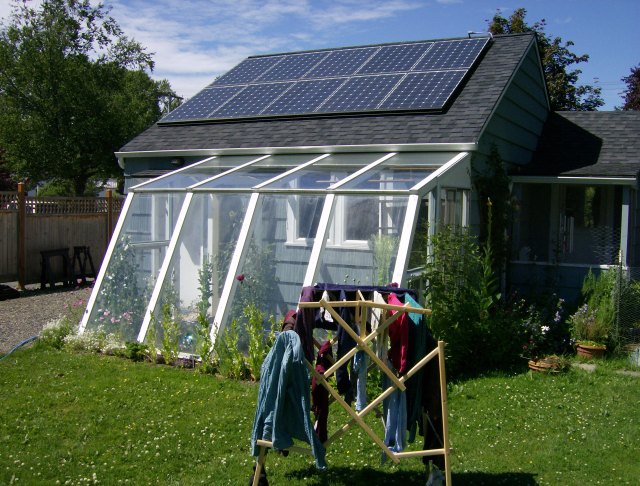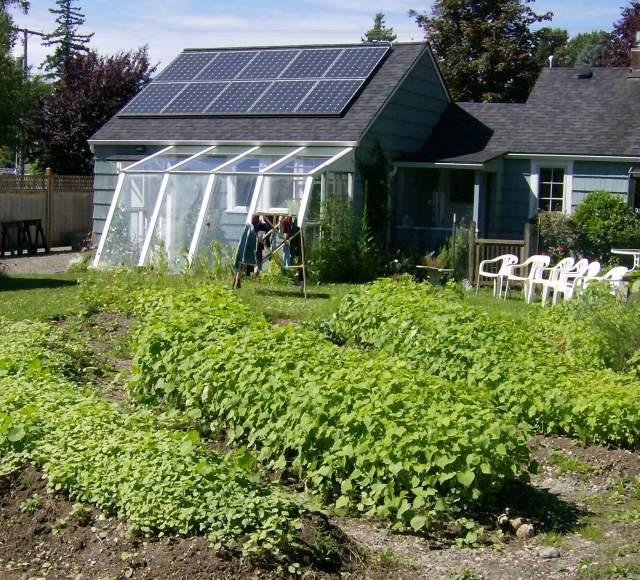Reblogged from my Integral Permaculture site.
Permaculture Principle #5: Use and Value Renewable Resources
“Make the best use of nature’s abundance to reduce our consumptive behaviour and dependence on non-renewable resources.”
As we go through the essential transition to declining energy, the limited and erratic nature of renewable energies provides a valuable negative feedback, reminding us that all natural resources must be used carefully and respectfully.
- David Holmgren, Permaculture: Principles and Pathways Beyond Sustainability
These photos were taken today in our backyard. How many uses of the sun can you identify? Which uses do you think best optimize the sun’s energy?
This season we are focusing our efforts more on rebuilding the soil, reshaping the garden beds (and by “we” I mean mostly head gardener Angela), and redesigning our landscape with swales, rather than an emphasis on food production. Hence the cover crop of buckwheat on these newly shaped garden beds.
And speaking of the sun’s power (amplified by the human caused greenhouse effect, i.e. climate change)…fellow blogger Robert Scribbler has a couple of worrying posts on the current heat wave being experienced on the west coast and it’s affect on Arctic Sea ice. See “Mangled Jet Stream and Global Warming to Shatter Earth’s Highest Re... and With ‘Warm Storm’ at Its Heart and Heatwaves Rushing in From The Si... .
Worst Case Melt Scenario May be Emerging
So by late June, it appears that the worst case melt scenario — with a storm hollowing out and melting the Arctic sea ice from the center and powerful warm air pulses delivered by a mangled Jet Stream rapidly melting the sea ice from its edges — may be emerging. A start to a ‘melt cliff’ that occurred this week, therefore, may extend and rapidly advance over the coming days. Model ensembles seem to support this forecast even as atmospheric heat delivery to the Arctic ramps up. It is an extreme situation that is well worth monitoring.
In more positive news (also related to the topic of this post), Robert’s latest post is about Renewables to Replace Nat Gas as World’s Second Largest Electricity...
Despite this positive news, it is important to keep in mind some caveats. David Holmgren again:
To harvest, store and use renewable energy sources requires varying inputs of high-quality (generally non-renewable) energy…In the case of wind power, the lower quality and erratic nature of the energy resource requires the much greater harvesting infrastructure. For solar electric power, the resource is most abundant but so low in quality that vast infrastructure is required relative to the quantity of harvested energy.
Despite these limitations, solar (photovoltaic) cells that convert sunlight to electricity have become the great symbol of renewable energy, out of all proportion in importance to a future with declining energy…I believe that a high-tech society running on solar cells is the stuff of dreams.
I am glad to have solar panels, but I don’t see them as a panacea, and I believe the jury is still out on how much net energy they generate after accounting for the varying inputs required for their manufacture (see here (check comments) and here for an alternate view). Why did I not put the wet clothes in our very efficient clothes dryer inside the house, and let the energy from the panels dry the clothes? Because using the direct energy of the solar clothes rack is much more efficient (when the sun is shining).
I asked at the top of the post, “Which uses [of the sun shown in the photos] do you think best optimize the sun’s energy?“ The answer is likely the trees in the background, and the grass and garden beds in the foreground.
Studies in biophysics providing curves of efficiency as a function of light intensity for isolated [green plant] cholorplasts show them to be more efficient than hardware cells. It may be that the natural conversion of sunlight to electric charge that occurs in all green plant photosynthesis after 1 billion years of natural selection may already be the highest net EMERGY [embodied energy] possible.
- Howard T. Odum, Environmental Accounting (quoted by Holmgren)
The ultimate development of the biological capture and storage of solar energy in forms useful to future generations of people is forest trees. Although trees do not yield electricity directly, they do most efficiently convert the very dilute solar energy into wood that we can more effectively substitute for many current uses of fossil fuel. For example, modern technology for wood gasifiers and micro-gas turbines appears to be a much more economical pathway for electricity production than solar cells.
- David Holmgren, Permaculture: Prinicples and Pathways Beyond Sustainability
Our neighbor carefully cultivates and harvests evergreen trees on his 1/2 acre plot next door (picture above). I’m not sure of the efficiency of his wood burning stove, but I believe he is making very good use of solar energy.
We should also note the intermediate technology of the greenhouse in the picture at top, especially since we used reclaimed glass rather than new. According to Holmgren, when you make use of another’s discarded materials, this should be classified under the Permaculture principle of “Obtain a Yield” (rather than “Produce no Waste“).
There are still at least a couple more uses or potential uses of the sun’s energy in the pictures up top that I haven’t discussed here. Can you name them?
I’ll give the last word once again to David Holmgren, the conclusion to his chapter on renewable resources:
The developing environmental orthodoxy is that we must increasingly separate all human support systems and ourselves from nature in order to prevent damage. This is a delusion created by generations of urban affluence separated from the cycles of nature. Although there are many positive and useful examples of environmental technology based on natural models, the underlying principles of separation of people from nature are philosophically and energetically flawed. We need to recognise that sustainable systems are more likely to emerge from an intimate parnership with nature, rather than application of natural design principles within the confines of the technosphere. Thus the slogan “nature knows best” is appropriate.
Comment
© 2025 Created by David MacLeod.
Powered by
![]()



You need to be a member of Transition Whatcom to add comments!
Join Transition Whatcom